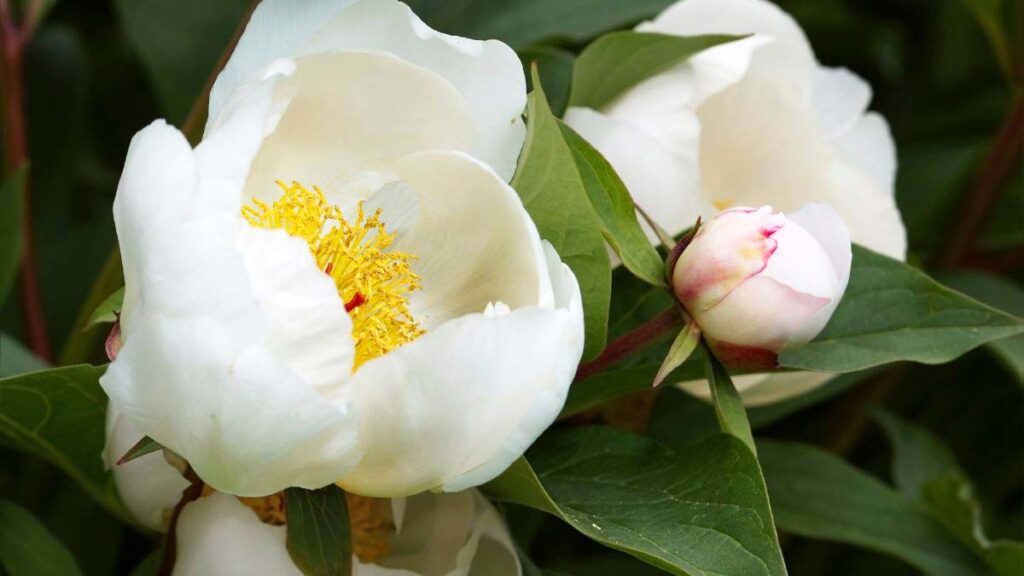In the realm of floral elegance, few blossoms command attention and exude timeless beauty quite like the white peonies. With petals as pure as freshly fallen snow, these ethereal flowers captivate the senses and inspire awe in their pristine simplicity. White peonies, scientifically known as Paeonia lactiflora, are renowned for their graceful demeanor and symbolize various virtues across cultures.
As delicate buds unfurl into opulent blooms, the white peonies emerge as emblematic representations of purity, elegance, and good fortune. Their creamy-white petals, soft to the touch, delicately cradle a symphony of subtle fragrances that waft through the air, creating an atmosphere of serenity and sophistication.
These exquisite flowers, nestled in lush greenery, beckon admirers to contemplate the marvel of nature’s craftsmanship. Their allure transcends seasons, as they bloom with grace in the spring, enchanting gardens and landscapes with their understated charm. White peonies, with their timeless allure, seamlessly blend into various settings, from traditional weddings to modern minimalist arrangements, adding an air of refinement to any occasion.
1. Athena – white peonies
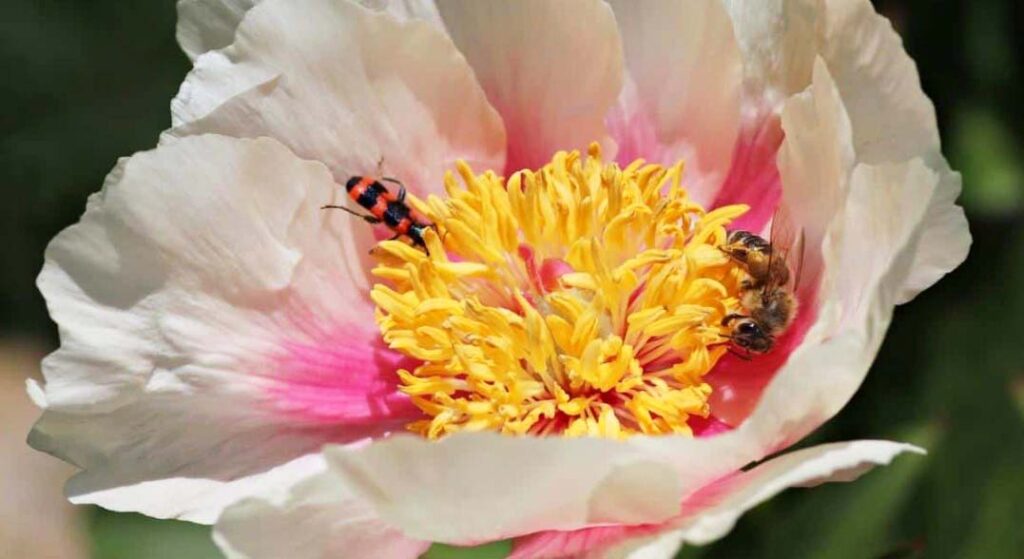
Plant Type
White Peonies, particularly the Athena variety, belong to the herbaceous perennial plant type. With their regenerative nature, these peonies grace gardens with their presence year after year.
Geographic Origin
Originating primarily from Asia, white peonies like Athena have a historical connection to China, where they have been cultivated and revered for centuries. Today, these blooms have found a home in gardens worldwide.
Plant Size
Athena white peonies boast an impressive size, reaching heights of around 2 to 3 feet. Their robust and well-defined stature makes them stand out in garden landscapes, adding both height and visual appeal.
Sun Exposure
Thriving under abundant sunlight, white peonies like Athena flourish in full sun exposure. Placing them in areas that receive at least six hours of sunlight daily ensures the optimal development of their stunning, pure-white blossoms.
Plant Zone
White peonies of the Athena variety are well-suited for planting in USDA hardiness zones 3 to 8. This expansive range underscores the adaptability of these peonies, allowing them to thrive in diverse climates and regions across the United States and beyond.
2. Bridal Shower
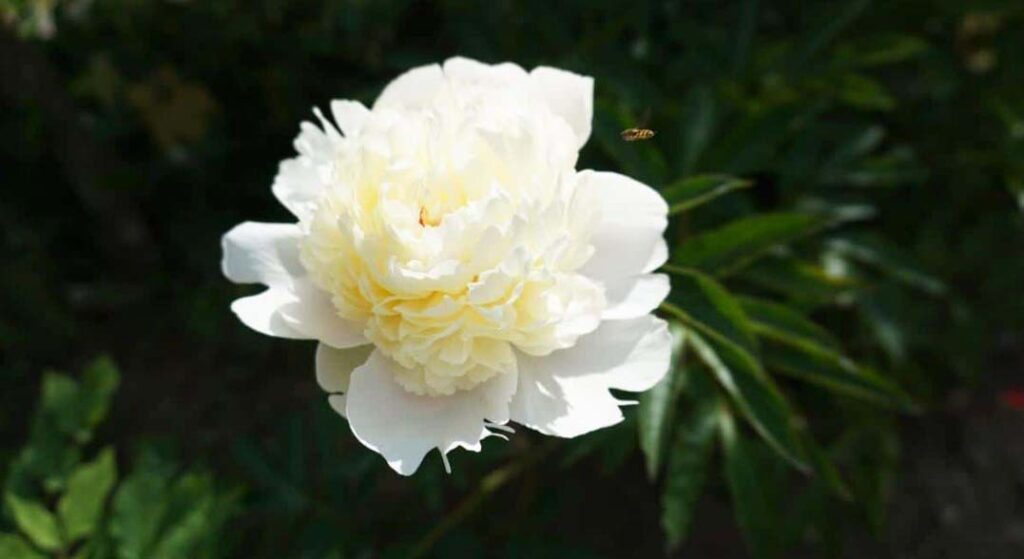
Plant Type
White peonies of the “Bridal Shower” variety belong to the perennial plant type. These enduring beauties grace gardens with their presence year after year, making them a cherished addition to any landscape.
Geographic Origin
Originating from Asia, white peonies, including the Bridal Shower cultivar, draw their roots from the rich soils of countries like China and Japan. Their journey from the East brings an exotic touch to gardens around the world.
Plant Size
The Bridal Shower white peonies exhibit a moderate plant size, striking a harmonious balance between bold presence and delicate allure. They typically reach a height of about 2 to 3 feet, providing a charming, eye-level display.
Sun Exposure
Thriving in the spotlight of the sun, Bridal Shower white peonies flourish under full sun exposure. Plant them in locations where they can bask in sunlight for the majority of the day, allowing their pristine blooms to unfurl in all their radiant glory.
Plant Zone
Ideal for USDA hardiness zones 3 to 8, Bridal Shower white peonies are adaptable to a range of climates. From cooler northern regions to milder southern landscapes, these peonies showcase their splendor across diverse plant zones, making them a versatile and resilient choice for gardeners.
3. Charles white peonies
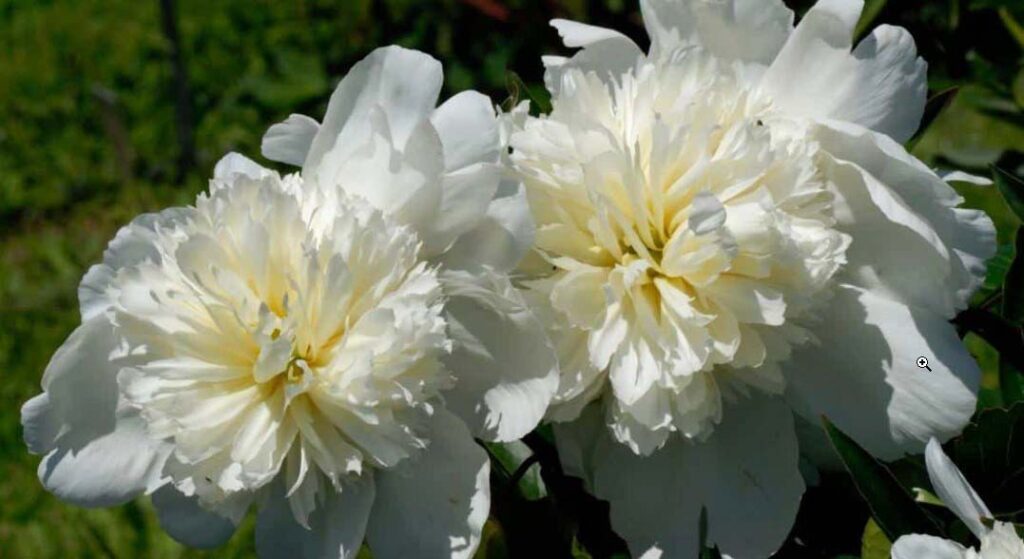
Plant Type
“White Peonies – Charles White” belongs to the herbaceous perennial plant type. These plants are known for their enduring presence, returning year after year to grace gardens with their delicate blooms.
Geographic Origin
Originating from China, white peonies, specifically the Charles White variety, carry the rich legacy of their Asian roots. Introduced to gardens worldwide, they seamlessly adapt to various climates.
Plant Size
Charles White peonies typically reach a moderate height, growing to about 2 to 3 feet tall. Their compact stature makes them ideal for both garden borders and floral arrangements, adding a touch of elegance to any space.
Sun Exposure
Thriving in sunlight, these peonies favor full sun exposure. Plant them in areas where they can bask in the warmth of direct sunlight for a significant part of the day to promote robust growth and abundant blooming.
Plant Zone
White Peonies – Charles White flourish in plant hardiness zones 3 to 8. Their adaptability to a range of climates within this zone makes them a versatile choice for gardeners seeking resilient and visually stunning additions to their landscapes.
4. Class Act
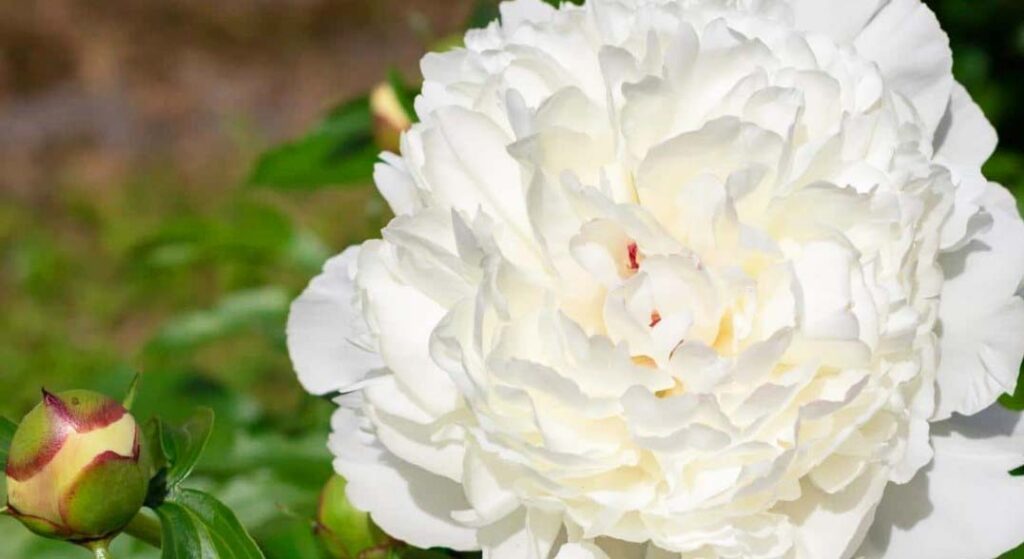
Plant Type
White Peonies of the “Class Act” variety belong to the herbaceous perennial category. These plants are known for their enduring nature, returning year after year with a display of exquisite blooms.
Geographic Origin
Originating from Asia, white peonies, specifically the “Class Act” variety, carry with them a rich history and cultural significance. They have been cherished for centuries, tracing their roots to regions like China and Japan.
Plant Size
Class Act white peonies boast a modest and manageable size, making them ideal for various garden settings. Typically, they reach a height of around 2 to 3 feet, creating a compact yet impactful presence in the landscape.
Sun Exposure
These peonies thrive under abundant sunlight. Providing them with full sun exposure ensures the development of robust plants and a profusion of those iconic, pristine white blossoms. A well-lit location enhances their overall health and vigor.
Plant Zone
Class Act white peonies thrive in specific plant hardiness zones. Ideally suited for zones 3 to 8, they adapt well to diverse climates, from cooler northern regions to milder southern areas. This adaptability contributes to their popularity as a versatile and resilient garden choice.
5. Elsa Sass
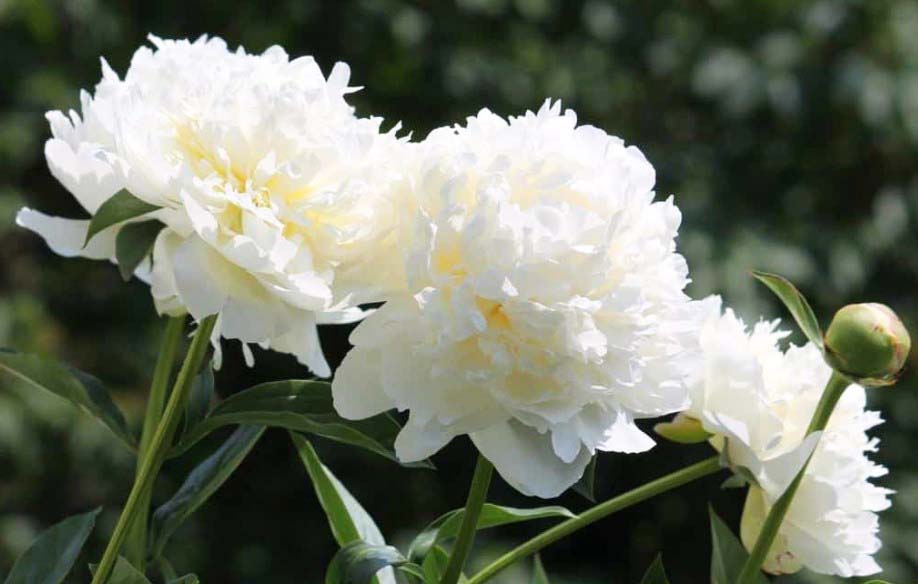
Plant Type
White peonies, specifically the enchanting Elsa Sass variety, belong to the herbaceous perennial category. As enduring plants, they exhibit a natural resilience and return each year to grace gardens with their exquisite blooms.
Geographic Origin
Elsa Sass white peonies trace their roots to the verdant landscapes of Asia and parts of Europe. Originating in regions with a rich horticultural history, these peonies carry a heritage that adds to their allure.
Plant Size
Elsa Sass peonies boast a moderate size, typically reaching a height of 2 to 3 feet. Their compact yet graceful stature makes them ideal for various garden settings, allowing for versatility in landscaping designs.
Sun Exposure
These white peonies thrive in areas that receive abundant sunlight. Providing them with full sun exposure ensures robust growth and a profusion of the iconic, pure-white blossoms that define the Elsa Sass variety.
Plant Zone
Elsa Sass white peonies flourish in plant hardiness zones 3 to 8. This broad range signifies their adaptability to diverse climates, making them a cherished addition to gardens across a significant geographic expanse. Gardeners in these zones can confidently cultivate the Elsa Sass variety, reveling in its timeless beauty and perennial charm.
6. Festiva Maxima
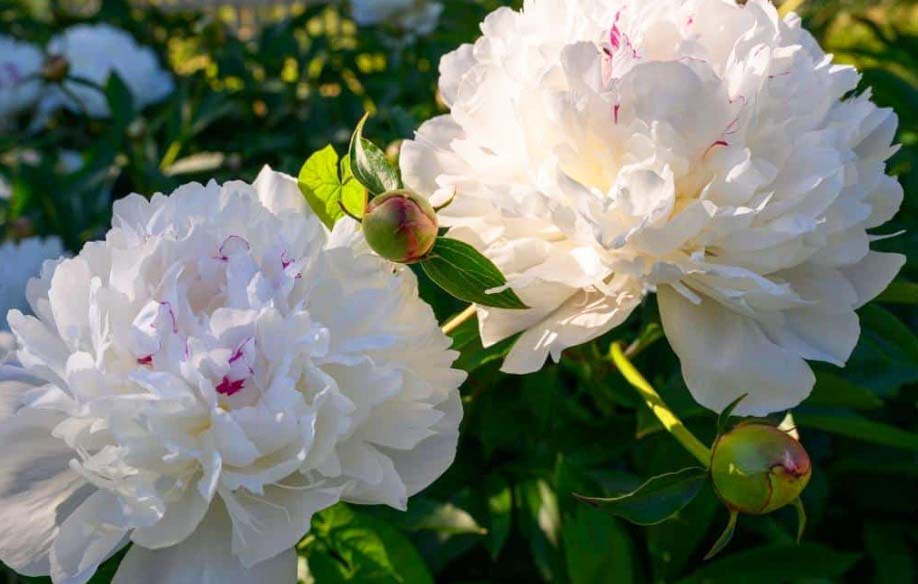
Plant Type
Festiva Maxima white peonies belong to the herbaceous perennial family, gracing gardens as enduring and regenerative plants. Their perennial nature ensures a return of exquisite blooms year after year.
Geographic Origin
Hailing from the scenic landscapes of Europe, Festiva Maxima peonies carry a rich botanical history. Originating in regions with a temperate climate, these peonies embody a timeless elegance reminiscent of their European heritage.
Plant Size
Festiva Maxima peonies exhibit a majestic size, typically growing to a height of 2 to 3 feet. Their impressive stature makes them a focal point in gardens, commanding attention with their lush foliage and striking, large blossoms.
Sun Exposure
Thriving under abundant sunlight, Festiva Maxima peonies prefer full sun exposure. This ensures robust growth and the development of their iconic, pure-white flowers with bold crimson flecks, creating a stunning visual display in gardens.
Plant Zone
Festiva Maxima white peonies flourish in a range of plant hardiness zones, specifically zones 3 to 8. This adaptability allows them to thrive in various climates, making them a sought-after choice for gardeners across a wide geographic spectrum. Gardeners within these zones can enjoy the enduring beauty and captivating presence of Festiva Maxima peonies in their landscapes.
7. Green Halo
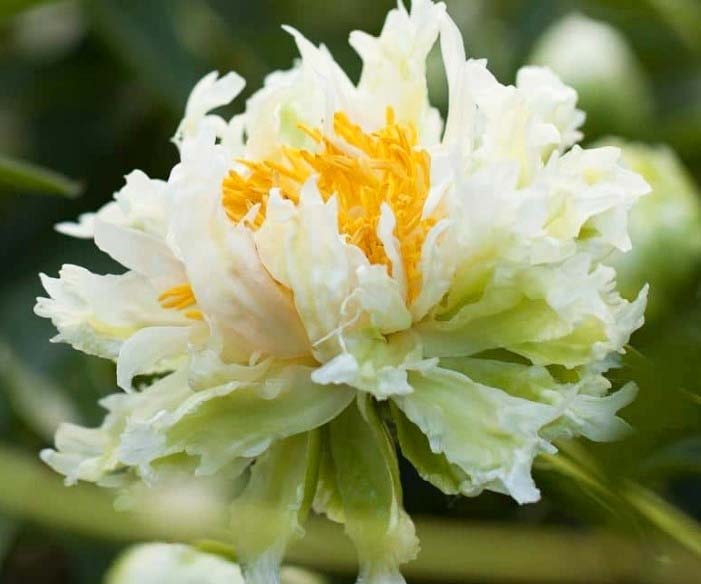
Plant Type
The Green Halo white peonies belong to the herbaceous perennial plant type. As resilient perennials, they exhibit the enduring quality of returning year after year, gracing gardens with their distinctive beauty.
Geographic Origin
Originating from the picturesque landscapes of Asia, the Green Halo peonies carry an exotic heritage. These peonies have their roots in regions with a rich horticultural history, contributing to their unique and captivating character.
Plant Size
Green Halo peonies showcase a moderate size, typically growing to a height of 2 to 3 feet. Their well-proportioned stature makes them a versatile choice for various garden settings, lending an elegant presence to landscaping designs.
Sun Exposure
Thriving under abundant sunlight, Green Halo peonies prefer full sun exposure. Providing them with the right amount of sunlight ensures robust growth and an abundant display of the iconic white blooms with the distinctive greenish center, characteristic of the Green Halo variety.
Plant Zone
Green Halo white peonies thrive within plant hardiness zones 3 to 8. This wide range signifies their adaptability to diverse climates, making them a favored choice for gardens across various geographic locations. Gardeners within these zones can confidently cultivate the Green Halo variety, appreciating its enduring beauty and perennial charm.
8. Bowl of Cream
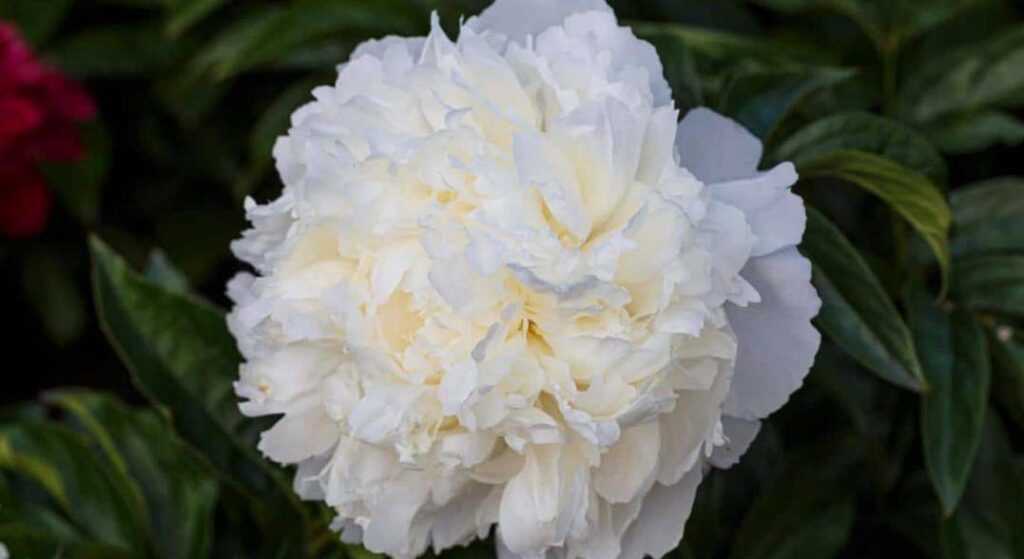
Plant Type
The Bowl of Cream white peony stands tall as an herbaceous perennial, showcasing its enduring nature by gracing gardens year after year. As a perennial plant, it brings lasting beauty to outdoor landscapes.
Geographic Origin
Hailing from the vibrant and diverse landscapes of Asia, the Bowl of Cream peony carries the botanical essence of regions with a rich horticultural legacy. Its origins contribute to the unique character that defines this particular variety.
Plant Size
With a stately presence, the Bowl of Cream peony typically grows to a height of 2 to 3 feet. This moderate size allows for easy integration into various garden designs, where its impressive blooms can command attention without overwhelming the landscape.
Sun Exposure
Thriving under the radiant glow of sunlight, the Bowl of Cream white peony flourishes in areas with full sun exposure. Providing this variety with ample sunlight ensures the development of robust and luxuriant blossoms, creating a spectacle of elegance in gardens.
Plant Zone
The Bowl of Cream peony finds its home in plant hardiness zones 3 to 8. This expansive range signifies its adaptability to diverse climates, making it a versatile choice for gardeners within this zone spectrum. Cultivating the Bowl of Cream variety promises a garden adorned with the timeless allure of its pure and pristine blooms.
9. Bride’s Dream
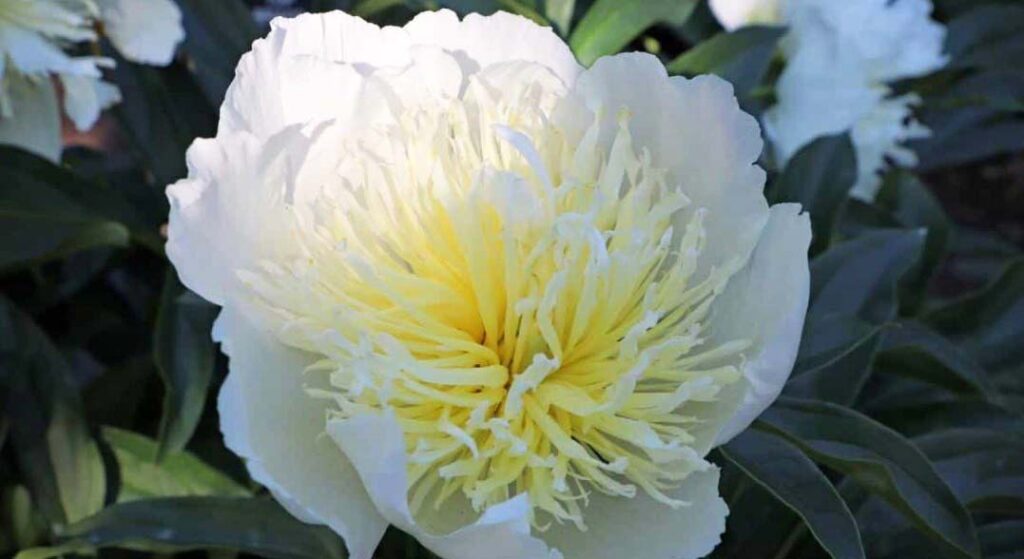
Plant Type
Bride’s Dream white peonies belong to the herbaceous perennial category, characterized by their enduring nature, returning each year to adorn gardens with their exquisite blossoms.
Geographic Origin
Hailing from the regions of Asia and Europe, Bride’s Dream white peonies carry a botanical legacy that adds to their allure, originating in landscapes with a rich horticultural history.
Plant Size
The Bride’s Dream variety boasts a moderate size, typically reaching a height of 2 to 3 feet. This compact yet graceful stature makes them well-suited for diverse garden settings, allowing for versatile landscaping designs.
Sun Exposure
Thriving in areas bathed in abundant sunlight, Bride’s Dream white peonies exhibit optimal growth and produce their iconic, pure-white blooms when provided with full sun exposure.
Plant Zone
Bride’s Dream white peonies flourish in plant hardiness zones 3 to 8. This wide range signifies their adaptability to varied climates, making them a cherished addition to gardens across a significant geographic expanse. Gardeners in these zones can confidently cultivate the Bride’s Dream variety, celebrating its enduring beauty and perennial charm throughout the seasons.
10. Cheddar Charm
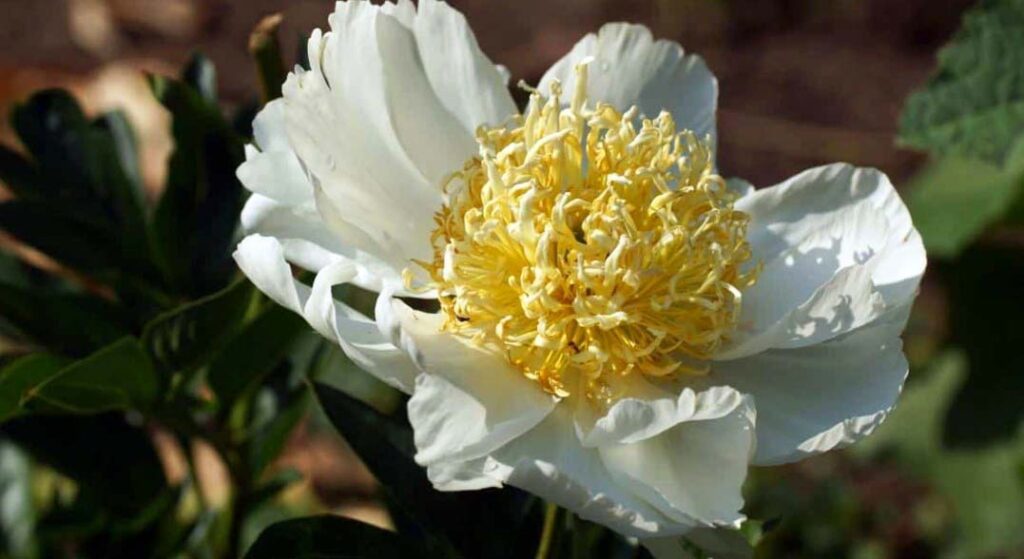
Plant Type
Cheddar Charm white peonies are classified as herbaceous perennials, demonstrating their enduring nature as they return each year to grace gardens with their charming blossoms.
Geographic Origin
Originating from the picturesque landscapes of Asia and Europe, Cheddar Charm white peonies carry a botanical legacy, rooted in regions with a rich history of horticulture.
Plant Size
The Cheddar Charm variety presents a moderate size, typically reaching a height of 2 to 3 feet. With their compact and charming stature, these peonies contribute to diverse garden settings, lending themselves well to creative landscaping designs.
Sun Exposure
Thriving in areas saturated with sunlight, Cheddar Charm white peonies achieve optimal growth and showcase their distinctive, creamy-white blooms when provided with full sun exposure.
Plant Zone
Cheddar Charm white peonies flourish within plant hardiness zones 3 to 8. This broad range highlights their adaptability to various climates, making them a cherished choice for gardens spanning a significant geographic expanse. Gardeners in these zones can confidently cultivate the Cheddar Charm variety, reveling in its enduring beauty and perennial grace throughout the changing seasons.
11. Duchesse de Nemours
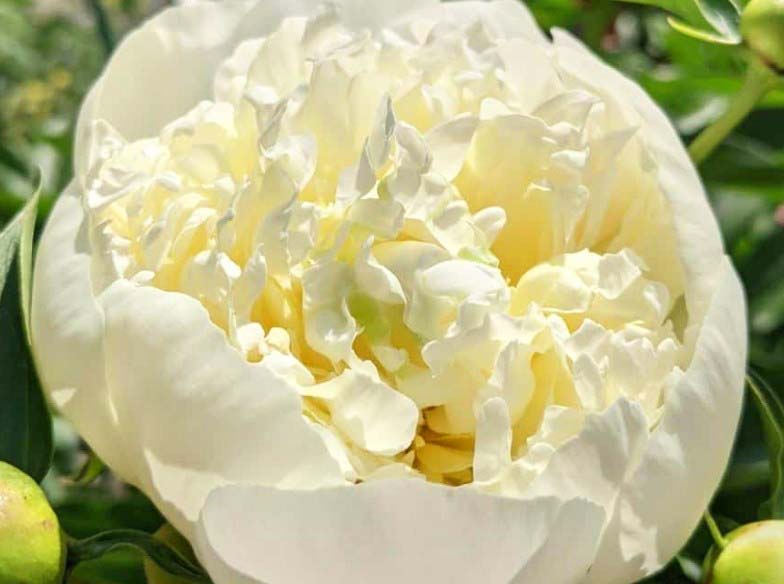
Plant Type
Duchesse de Nemours white peonies are classified as herbaceous perennials, demonstrating their enduring nature by returning each year to grace gardens with their captivating and elegant blooms.
Geographic Origin
Originating from the regions of France, the Duchesse de Nemours white peonies boast a storied botanical heritage, adding a touch of European charm to gardens.
Plant Size
With a moderate size, typically reaching 2 to 3 feet in height, Duchesse de Nemours peonies exhibit a graceful stature. This makes them well-suited for various garden settings, contributing to the charm of landscapes with their timeless beauty.
Sun Exposure
Thriving in areas that receive ample sunlight, Duchesse de Nemours white peonies showcase optimal growth and the development of their distinctive, pure-white blossoms when provided with full sun exposure.
Plant Zone
Duchesse de Nemours peonies thrive in plant hardiness zones 3 to 8. This wide range underscores their adaptability to diverse climates, ensuring they can be cultivated and enjoyed in gardens across a significant geographic expanse. Gardeners in these zones can cultivate Duchesse de Nemours with confidence, appreciating the enduring allure and perennial elegance these white peonies bring to their outdoor spaces.
12. Feng Dan Bai
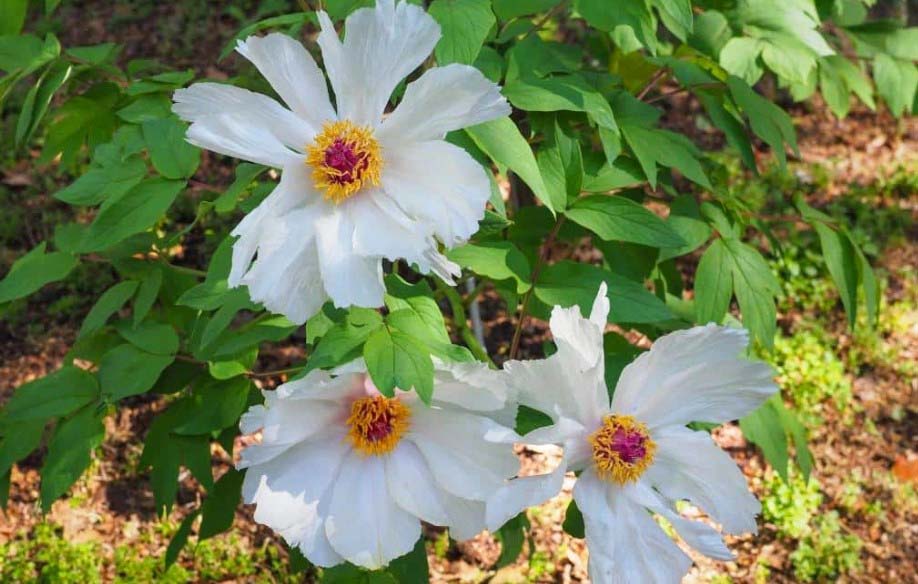
Plant Type
Feng Dan Bai white peonies belong to the herbaceous perennial category, showcasing their enduring nature as they return each year to grace gardens with their captivating and elegant blooms.
Geographic Origin
Originating in the lush landscapes of Asia, Feng Dan Bai white peonies boast a rich botanical heritage, deriving their beauty from regions with a deep horticultural history.
Plant Size
The Feng Dan Bai variety presents a moderate size, typically reaching heights of 2 to 3 feet. Their graceful stature makes them well-suited for a range of garden settings, contributing to diverse landscaping designs with their timeless appeal.
Sun Exposure
Thriving in areas saturated with abundant sunlight, Feng Dan Bai white peonies exhibit optimal growth and bloom production when provided with full sun exposure. This ensures the manifestation of their iconic, pure-white blossoms.
Plant Zone
Feng Dan Bai white peonies flourish in plant hardiness zones 3 to 8. This broad range signifies their adaptability to various climates, making them a cherished addition to gardens across a significant geographic expanse. Gardeners within these zones can confidently cultivate Feng Dan Bai, appreciating its enduring beauty and perennial charm in different environmental settings.
13. Gardenia

Plant Type
The Gardenia white peonies belong to the herbaceous perennial category, gracing gardens as resilient, recurring plants that showcase their exquisite blooms year after year.
Geographic Origin
Originating from the lush landscapes of Asia and parts of Europe, the Gardenia white peonies carry a botanical legacy that adds to their allure, reflecting the beauty of regions with a rich horticultural history.
Plant Size
The Gardenia variety presents a moderate size, typically reaching a height of 2 to 3 feet. With a graceful and compact stature, these peonies seamlessly complement various garden settings, allowing for versatile and elegant landscaping designs.
Sun Exposure
Thriving under abundant sunlight, Gardenia white peonies exhibit optimal growth and display their iconic, pure-white blossoms when provided with full sun exposure. Their beauty unfolds best in well-lit environments.
Plant Zone
Gardenia white peonies flourish in plant hardiness zones 3 to 8. This broad range underscores their adaptability to diverse climates, making them a cherished addition to gardens across a significant geographic expanse. Gardeners within these zones can confidently cultivate the Gardenia variety, enjoying its enduring beauty and perennial charm throughout the seasons.
14. Honey Gold
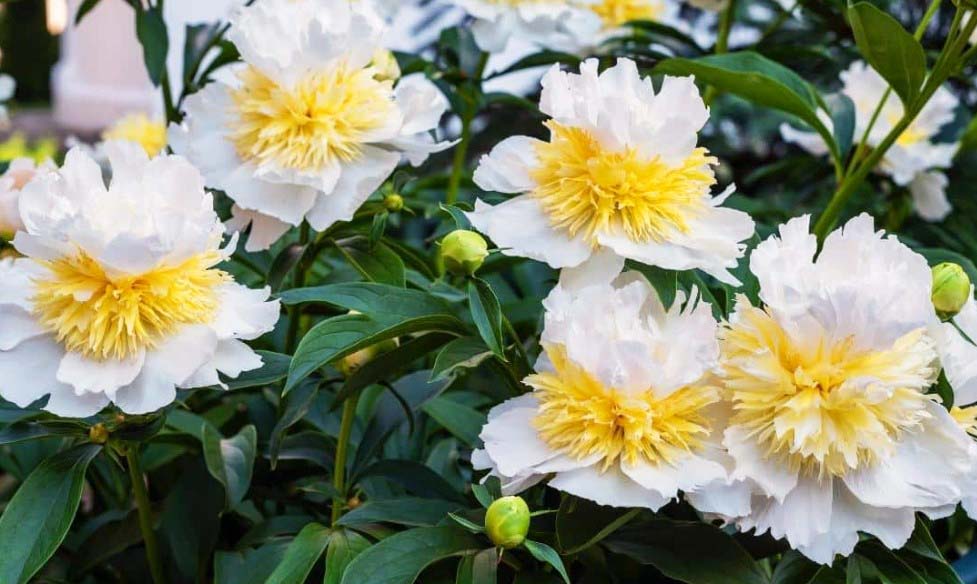
Plant Type
Honey Gold white peonies belong to the herbaceous perennial family, showcasing their enduring nature by returning each year to grace gardens with their stunning blossoms.
Geographic Origin
Originating from regions in Asia and Europe, Honey Gold white peonies carry a rich botanical history, their beauty rooted in landscapes with a horticultural legacy.
Plant Size
The Honey Gold variety presents a moderate size, typically reaching heights of 2 to 3 feet. Their compact yet graceful stature makes them an excellent choice for a variety of garden settings, offering flexibility in landscaping designs.
Sun Exposure
Thriving in areas basked in ample sunlight, Honey Gold white peonies exhibit optimal growth and produce their distinctive, honey-colored blooms when provided with full sun exposure.
Plant Zone
Honey Gold white peonies thrive in plant hardiness zones 3 to 8. This broad range underscores their adaptability to diverse climates, making them a cherished addition to gardens across various geographic areas.
FAQ
What do white peonies symbolize?
White peonies symbolize purity, innocence, and a sense of new beginnings. Their pristine petals convey a message of sincerity and grace, making them popular choices for weddings, representing a pure and everlasting love. In various cultures, these blooms are associated with good fortune and prosperity. The symbolism of white peonies transcends mere aesthetics, embodying a timeless elegance that carries deep cultural and emotional significance.
What is white peony good for?
White peony, both a beautiful flower and a medicinal herb, offers various health benefits. Its roots, used in traditional medicine, are known for anti-inflammatory properties and may alleviate menstrual discomfort. White peony extract is also believed to have immune-boosting and antioxidant effects. Additionally, it’s valued for promoting liver health and reducing stress. Whether enjoyed for its aesthetic appeal or utilized for wellness, the white peony proves itself as a versatile and beneficial plant.
Are peonies expensive?
Peonies can be relatively expensive due to their short blooming season and high demand. The limited availability, coupled with their popularity for weddings and special occasions, contributes to their higher cost. Factors like variety, color, and regional availability can also influence the price. While they may be considered a luxury bloom, their beauty and symbolism make peonies a sought-after and cherished flower, often justifying their price in the eyes of those who appreciate their unique charm.
Why is it called a peony?
The term “peony” is derived from the Greek mythological figure Paeon. According to legend, Paeon was a student of the god of medicine, Asclepius. As Paeon used a peony root to heal Pluto, the god of the underworld, from a wound, jealous Asclepius turned Paeon into the flower we now know as the peony. The name pays homage to this myth, intertwining the flower’s origin with a tale of healing and transformation.
Conclusion
The timeless elegance of white peonies transcends mere botanical beauty, weaving a rich tapestry of cultural significance and symbolism. These delicate blooms, with their lush, layered petals, have become more than just flowers; they embody purity, innocence, and the promise of new beginnings. From ancient Chinese imperial courts to modern weddings, white peonies have gracefully stood the test of time, symbolizing prosperity, love, and the enduring beauty of nature.
Whether adorning floral arrangements, gracing gardens, or preserved as cherished keepsakes, white peonies captivate with their ethereal charm. The act of planting and caring for these blooms becomes a journey of cultivating not just a garden but a connection to history and tradition.
